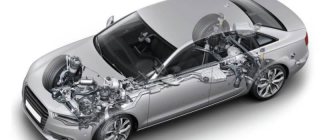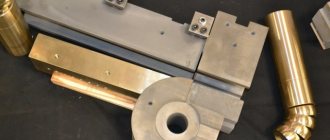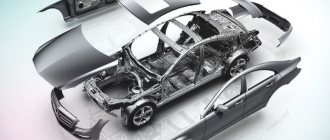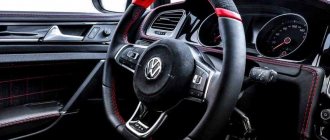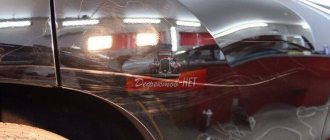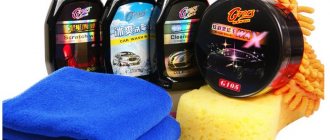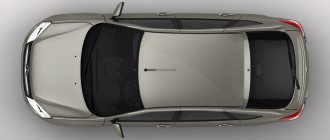31.10.2019
| (Votes: 1, Rating: 5) |
Issues discussed in the material:
- What is the significance of control points when measuring body geometry?
- What, besides an accident, can change the geometry of the body
- Why is it useful to diagnose body geometry not only after an accident or before purchasing?
- Is it possible to carry out high-quality diagnostics of body geometry in a garage?
- Do I need to align wheels before measuring body geometry?
The average car owner can use his car for a long time without being at all interested in such a concept as body geometry. However, this characteristic affects not only the appearance of the machine, but also the safety of its operation. In this article we will tell you what body geometry is, how to check this parameter, in what units it is measured and what its violation can affect. In addition, we will consider the main options for checking and measuring this characteristic in garage conditions and at specialized car repair shops that perform body repairs using modern technological equipment.
What do body geometry control points mean?
To get an idea of the characteristic under consideration, you should first of all understand the concept of control points, which are necessary for correct measurements.
Most of the vehicle's control points are technological holes in the elements of its body. In principle, control points can be all stationary elements on structural body parts. For example, you can measure the distances between symmetrical corners of the body.
It is necessary that the control points be in horizontal or vertical planes. Their location may differ for different car models (usually this is indicated in the car repair manual, which also shows the distance between specific control points).
When checking body geometry, dimensions are taken into account between the centers or edges of the control holes.
As a rule, this is the distance between the centers of stationary holes, which are located on opposite parts of the car body. If such holes have a sufficiently large diameter, you need to measure the distance between their edges.
We recommend
“Methods of tinting headlights: which one to choose” More
If necessary, measurements can be made of the distance between certain fastening points of chassis parts that affect wheel alignment indicators. In addition, wheel angles can also be measured.
After an accident, as a result of which the car body was deformed, the central plane of the car body is determined using control points (for this, points located on the undamaged part of the car are used). Starting from such a plane, you can determine the presence of deviations on the damaged side and correctly carry out work to restore the body.
To check the geometry of the body using a measuring ruler, you should find data on the factory parameters for the distance of control points. When taking measurements, it is very important to consider which dimensions are indicated in the instructions - between centers or between the edges of the holes. If it is not possible to obtain factory data on the body geometry of a specific car model, then the parameters of a similar undamaged car are used as reference dimensions. In addition, it is possible to compare the distances between control points located on the undamaged side of the body.
What cars do we work with?
Repair and painting for all popular car brands
Audi
BMW
Chevrolet
Citroen
Ford
Honda
Hyundai
Infiniti
KIA
Land Rover
Lexus
Mazda
Mercedes
Mitsubishi
MINI
Nissan
Opel
Peugeot
Porsche
Renault
Skoda
SsangYong
Subaru
Suzuki
Volkswagen
Volvo
Lada
What is car body geometry
What is included in the concept of car body geometry? How and with what devices are measurements of this geometry carried out? The concept discussed in our article can be characterized as a system established by the manufacturer for arranging control points of the body relative to each other. In other words, the geometry of the body determines the exact location of body parts, ensuring the coordinated operation of components and assemblies mounted on the body. The location of such parts can be determined by the dimensions of the diagonals of the door openings, engine compartment and trunk.
The most important control dimensions of the body geometry show the distance between the elements that perform a load-bearing function in relation to the suspension units (the distance between the side members, cups and other body parts to which the suspension is attached).
Thus, we can conclude that the geometry of the body affects the wheelbase of the car, wheel size and other characteristics, which are an important component of a comfortable and safe ride. In this regard, it is necessary to carefully consider this parameter. What factors lead to violation of body geometry?
These consequences can lead to:
- road surface defects;
- obstacles on the roads;
- Road accidents and consequences of natural disasters.
Factors that lead to a violation of the body geometry can have different effects, which affects the degree of change in the distances between control points.
For example, all the unevenness of the road surface and the load that occurs when accidentally hitting obstacles are mainly borne by the chassis of the car, but at the same time, the body can also receive deformations that are imperceptible at first glance, which accumulate over time.
The first signs of a violation
More than half of drivers do not carry out regular measurements between technological holes, even on their own after body repairs. When purchasing a car on the secondary market, you need to go to a specialized service station to check it; often information about the factory dimensions of a particular brand is not available. There is a fee for the inspection, but cost savings can result in major repairs in just a few months. Signs that the body geometry is broken:
- The doors to the cabin, the hood, and the trunk are hard to close.
In VAZ cars, the trunk may not close well, not due to broken geometry, but due to faults with the locks. This is a typical VAZ breakdown that is familiar to many.
- 80% of subsidence of parts is associated with deformation of the racks, and not with breakdowns in fasteners.
- At a speed of more than 80 km/h, the car “throws” from side to side, and body vibration appears. When inspecting the components, all units are working properly, there is no body vibration.
- Frequent breakdowns in the chassis are a sign of deformation of the cups and side members.
A torn engine mount is the first sign of a damaged structure, even if there was no accident.
Why check the geometry of the car body
Diagnosis of body geometry is one of the main checks that experts recommend to carry out before buying a used car. This will allow the potential buyer to find out whether the car was involved in an accident, in what conditions it was operated and how well its repairs were carried out.
In some cases, measuring the distances between control points is carried out to check the quality of straightening and body repair. The owner of a car that has been repaired after an accident does not always pay due attention to checking the quality of the work performed. At first glance, everything may look quite good, but it is not always possible to restore the body after an accident using simple straightening and pulling out dents. In some cases, it is necessary to replace individual body elements, or to carry out “cold” or “hot” drawing of parts. Poor quality restoration of body geometry can lead to serious troubles in the future.
Car owners who take responsibility for the condition of their car try to regularly check the correctness of the body geometry. You can find recommendations from experts regarding the annual measurement of distances between control points. Moreover, some car services offer their clients to check the body geometry every six months. If we take into account the state of domestic highways, then such recommendations can be considered quite reasonable.
Some car owners, without even specifying how much body geometry costs, claim that these are pointless expenses. Such drivers should be aware of the existence of a number of signs in which such a diagnosis should be carried out as soon as possible. The sooner they contact a car service, the less they will have to pay to eliminate defects.
- The first sign of a violation of the geometry of the car body is poor closing of the hood, trunk or doors. If the cause of difficulty closing the doors is not sagging hinges, then there is deformation of the pillars or other body elements.
- The second sign of significant body deformation will be much more dangerous. It is associated with unstable behavior of the car at high speeds. It can “yaw” in different directions, vibrate while moving, or the car will pull strongly in one direction. If the reason for this behavior of the car is not a faulty suspension, then there is a serious problem with the side members, cups or other load-bearing elements.
What is camber, standard indicators (numbers), how is it regulated?
Camber is a parameter that reflects the angle of inclination of the wheel relative to the vertical plane.
Collapse happens:
- Positive. In this case, the top side of the wheels deviates to the sides (outward).
- Negative - the upper parts of the wheels are brought inward.
The main purpose of the camber is to dampen steering wheel vibrations in the event of a collision with an obstacle. Vibrations are not transmitted through the steering linkage, but are damped due to the elasticity of the wheels.
Violation of the camber leads to the following consequences:
- Deterioration of tire contact with the road;
- Reduced stability on sharp turns;
- Acceleration of tire wear;
- Changing the rolling radius.
In most cars, except those with MacPherson suspension, the camber is 0-45\' (sometimes up to two degrees).
On vehicles equipped with a MacPherson suspension, the camber is negative or zero, which is due to the special design features of the vehicle.
As for the design features of cars with MacPherson suspensions, they do not provide for adjustment of toe angles.
Common causes of camber problems:
- Violation of the integrity of the levers;
- Destruction of rubber-metal hinges;
- Deformation of hub units and struts.
This is possible when falling into holes or open hatches, or with a strong impact on curbs.
If the camber has a slight deviation, then it is adjusted. To do this, you will have to unscrew the two bolts connecting the shock absorber strut bracket and the steering knuckle and, by moving the latter, achieve standard indicators.
Be sure to mark the bolts to remember their position.
This adjustment is typical mainly for domestic cars and some foreign cars.
If the deviations are very large and cannot be adjusted, then replacing the shock absorber allows you to return the indicator to normal. If the parameter diverges more (from 2 degrees and above), then check the hub and axle.
Rules for measuring car body geometry
- To correctly measure the distances between control points, you need to place the car on a flat surface and check the pressure in the wheels (it should be the same). Some measuring rulers have a built-in level that allows you to measure parallel to the plane of the car (parallel position of the rulers is often a necessary condition in order to accurately compare the obtained data with accurate data regarding the distance between control points). It should be noted that some repair manuals may contain information on distances expressed in scale values of the measuring ruler, while other documentation may provide actual distances between test points (these are usually completely different data). To measure distances on a ruler scale, the measuring device must be placed parallel to the body. Otherwise, the readings will be incorrect. To satisfy the parallelism requirement, the ruler pointers must be extended to different lengths. In this case, the readings on the ruler scale will differ from those that can be obtained using a tape measure (the actual distance between the control points). If the ruler pointers are extended to the same distance when taking measurements, then the value on its scale will be the same as the actual distance from one point to another.
- Measurements should be taken between fixed points of the body (technological holes, mounting connectors, bolts, etc.).
- Each measurement must be checked using 2 auxiliary control points.
It is preferable to measure distances between the most distant control points. With such measurements, the picture of the displacement of structural elements of the body will be more reliable. - Sometimes taking measurements between similar control points, which are located on opposite sides of the body, allows you to obtain more objective information regarding the presence of deformations than diagonal measurements. Diagonal measurements must be supplemented with measurements along the length of the body.
- Checking the distances between control points accepts a total tolerance not exceeding 3 mm (this is the error that was acceptable for automakers for a long time). Modern technologies make it possible to produce car bodies with zero error.
We recommend
“How to wash your windshield quickly and without problems” More details
- Measuring the distances between control points, which are technological holes of equal diameter, is carried out between their centers or from edge to edge. Measuring the distances between fasteners (for example, between bolts) is carried out from center to center.
- If you need to measure the distance between holes that have different diameters, then you need to take 2 measurements. First, the distance between the inner edges of the holes is measured, and then between the outer ones. To find the distance between such holes, the results obtained must be added and divided by two.
Technical characteristics of the car
The five-door Granta model with a liftback body absorbed the best qualities of its classmates, retaining the strong body of a sedan and the large trunk volume of a hatchback. At the same time, she has a swift, dynamic appearance. To enhance the strength of the body, additional stiffening ribs were used, located between the trunk floor and the wheel arches, and the thickness of the floor and side members was also increased. The raised window line, sloping roof and new body kit, front and rear bumpers added originality to the design. Improved aerodynamics of the car made it possible to reduce hydrodynamic resistance, reduce fuel consumption and eliminate contamination of the rear window.
The Granta liftback is available in standard, classic, comfort and luxury trim levels. To designate a particular configuration, indices are added to the main model number. For example, VAZ 219110 is standard, VAZ 219170 is classic start, and so on.
The geometric dimensions of the Lada Granta liftback are shown in the figure.
The main technical and dynamic characteristics of the Grants in the liftback body are given in tables 1 and 2.
Table 1. Car parameters depending on the type of engine and gearbox
Units and parameters
Indicators
Table 2. Characteristics of the Lada Granta liftback depending on the configuration
Equipment
Number of valves
Since the release of the first batch of Lada Granta liftback, several crash tests have been carried out. The first one was made in the Czech Republic with one airbag, the result was 8.4 points out of 16. Not bad for a car in this class, considering the performance of such cars as Hyundai Solaris (8.5 points), Hyundai Accent (8.9 points), Chevrolet Lanos (8.1 points) and Fiat Albea (7.5 points). The geometric dimensions of the passenger compartment remained almost unchanged upon impact, and the driver, if this had happened, would not have received any damage other than fright.
How to check the geometry of a car body
The opinion that the absence of deviations in the car's wheel alignment indicators can serve as confirmation of the correct body geometry is erroneous. Body diagnostics is a separate procedure that requires special stands and stocks.
Using such devices, using control points, you can check the conformity of the dimensions and diagonals of the engine compartment, trunk, doorways, as well as the distance between side members, reinforcements, load-bearing body parts, etc.
There are three options for checking body geometry:
- Carrying out measurements of distances between control points. This type of diagnostic allows you to quickly check the correctness of the geometry both before starting repair work and during its implementation. Such measurements are carried out using a regular tape measure or a special ruler.
- During comparative measurements, the correspondence of the distances between symmetrical points located on opposite sides of the body is analyzed. This type of test is distinguished by its versatility and ease of diagnosis of body damage. As a rule, experts compare the length of the diagonals between symmetrical points of the body. In this case, you can compare the measurement data on the damaged and intact sides of the car.
- In three-dimensional measurement, the spatial location of control points is determined in relation to the base planes of the body. For such diagnostics it is necessary to have special equipment.
During the measurements, a specialist can determine the extent of the main damage, determine the presence of minor defects and outline a plan for restoration work.
To measure the geometry of the body, measuring rulers are used or stationary equipment is used, a slipway, which allows you to check the distances between control points using special marks or electronic beacons.
To do this, the car is fixed on a platform using chains and measuring sensors are hung on certain points of the body. Quite often, craftsmen are faced with a situation where control points are hidden under the skin of body panels, under bumpers, under protective elements, so they have to partially disassemble the body to provide access to hidden places.
In order to restore the original parameters of the body geometry, straightening work is carried out in a car service center. This is a rather complex and multi-stage job that must be performed by qualified craftsmen who have the appropriate education, experience and a good feel for metal.
Garage specialists can tell you that they can easily restore your car after an accident using a special certified line. But such assurances should not be trusted. Without equipment such as a slipway, the geometry of the body after a serious accident cannot be fully restored. Cars repaired in artisanal conditions, as a rule, have deviations in body geometry.
We recommend
“Chip on the glass: what to do in this situation” More details
We have already noted that body diagnostics using control points should be carried out at least once a year or every 30 thousand km. mileage
If the car service is not equipped with special stands, then a body repair technician can use a ruler to measure the geometry of the body, but this is not a very reliable method, which can give an error of about 5 millimeters in one direction or another.
On the slipway you can measure the dimensions of such body elements as:
- luggage compartment opening;
- engine compartment;
- front and rear side members;
- window openings;
- doorways;
- sections of the front, middle, rear of the car.
To straighten the car frame, auto repair shops use hydraulic equipment and vacuum suction cups.
Complete restoration of body geometry (correction after serious accidents) can be carried out by stretching, but only if the metal has retained its characteristics.
Diode pointers are used for computer body diagnostics. This device allows you to perform all the necessary measurements without disassembling. For diagnostics, the machine is installed on a stand. The computer program will take all the necessary measurements and apply them to a virtual template of a specific car model. Such a check takes about 10 minutes, and the owner of the car receives a printout of the body with marked problem areas. The permissible error of such diagnostics is within 5 mm.
ALEX1887 › Blog › Body measurements
It’s a shame, having received a car from body repair at a service station or in a workshop, to find that it drives somehow wrong: it pulls to the side, does not obey the steering wheel well, does not hold the road well, although the alignment and camber of the front wheels have been checked more than once after the repair. An experienced motorist will immediately determine the reason: the geometry of the body is broken, and when asked “what to do!” will answer: “Replace the car.” Is it possible to avoid this and how, says Candidate of Technical Sciences A. NAUMOV.
By “body geometry” we mean the location of some of its points relative to each other and the axes of the car. These are, first of all, points that determine the position of the front and rear axles (and therefore the wheels), and the engine. Their displacement causes a deterioration in the driving properties of the car (and with it tire wear, increased fuel consumption, etc.). A change in the position of the machine's center of gravity also has a negative effect. The trouble is that when repairing a body deformed after a collision or due to severe corrosion, due attention is not paid to restoring the position of these basic points. In the best case, only two of the three technical requirements for monitoring geometric parameters are fulfilled (these requirements are set out in TU 37.009.021-88 “Acceptance, repair and release of passenger car bodies from repair by auto service enterprises”: check the size of the gaps in the doors, hood and trunk lid , as well as the installation angles of the steered wheels. The requirements regarding the relative position of suspensions and axles are often ignored. These same specifications provide a simple verification method, which boils down to measuring with a conventional tape measure the diagonal and longitudinal distances between the symmetrical points of the front and rear suspensions and bridges (Fig. 1).
The permissible difference between diagonal and longitudinal dimensions is no more than 0.4% of the larger value. It is useful for the service station client to know his rights, which are defined, in particular, in paragraph 4.5 of the same technical specifications: “The transfer of the body or its component to the customer can only be carried out with positive control results. Upon receipt of the body or its components, the customer has the right to check the quality of the work performed by the service station.” It must be said directly why service stations do not advertise these documents: it is very difficult to ensure the required geometry of the body base and control during the repair process without special equipment, and the “by eye” method that is used can lead to a conflict if the client is aware of control methodology will require eliminating deviations. How do reputable enterprises operate? At the AvtoVAZ Maintenance Center, the position of the attachment points of the front and rear suspensions, anti-roll bar and other critical chassis elements must be checked on a special slipway - BS-1 23.000. (Stands for the same purpose were also developed at Rosavtotekhobluzhivanie.) To the maximum extent possible, it reproduces the jigs used by the plant when assembling bodies. The slipway is a fairly rigid frame with brackets on which controlled holes are fixed in the elements of the underbody using pins. If the body is deformed, it will not be possible to install the pins. This control method is effective in eliminating complex damage when you have to disassemble the car, remove axles and gearboxes. It allows you to install new side members and other parts of the body base with guaranteed accuracy, eliminating the possibility of errors associated with measurements. But, as we see, it is very labor-intensive. Therefore, another method that does not require disassembling the car has become more widespread abroad. It is based on measuring the distances between the points indicated in the map of control measurements with which the manufacturer supplies its vehicles (Fig. 2).
Is it possible to diagnose body geometry at home?
If restoring the body geometry in a car service is not suitable for you, then if necessary (for example, if problems with the car’s handling begin to appear for no apparent reason), this procedure can be performed independently in the garage. To measure you will need the following equipment:
- folding measuring ruler;
- tape measure without additional backlash;
- scale rod;
- compass;
- calipers.
You can determine the exact location of control points using the technical documentation for your vehicle. If you don’t have such documents at hand, you can look it up on the Internet. We recommend using the official websites of the manufacturer of your model. It is easier to find technical documentation for Japanese cars (it is freely available) than for European models.
How to check body geometry with your own hands:
- Look by eye to see if the car doors, trunk lid and hood do not close tightly. Check the distance of door openings.
- Using a tape measure, measure the distance between the axles. To do this, the car must be placed in a pit.
- Measure the transverse distance between the wheel axles.
- Determine where control points are located using technical documentation.
- If problems arise with access to control points, the casing must be removed.
- Measurement starts from the central part of the body.
- Measure the diagonal distance between the control points in the engine compartment.
- Measure the distance between the reference points, bolts, frame guides and reference points on the power block.
- After each measurement, carry out additional measurements to ensure that the data is correct.
- Check the roof diagonally.
Discrepancies of 0.5 cm indicate an average degree of change in geometry, more than 1 cm indicate significant deviations in distance.
- Measuring body geometry with a tape measure
When using a tape measure, you must be guided by several rules: no obstacles for taking measurements between control points; the measured values on the scale must be viewed at an angle of 90 degrees and from the same place (this is important for obtaining the most correct data); The tape measure tape clamp must have no additional play.We recommend
“Replacing a windshield on a KIA: complete information” More details
For correct measurements, the tape measure must be placed absolutely evenly between the control points. When working with short distances, modify the clamps. - Measuring body geometry with a ruler
The most common device for measuring body geometry is a special geometric ruler.With this ruler you can take measurements between two reference marks. However, after each measurement you need to check by measuring additional points.
A modern measuring ruler, designed to measure body geometry, is a special telescopic device that allows you to adjust the height indicators. Since the ruler is foldable, even at full length, the data will be measured accurately. Sometimes additional measurements of indicators are necessary (this depends on the type of ruler selected). The measuring ruler also comes with accessories: attachments and special extensions for a tight fit at the control points.
Even if there are some obstacles between the two points being measured, the ruler will still provide accurate data.
If you look at a car, it is symmetrical (if you draw an imaginary line along its center). However, it is worth noting that some points of the machine may be asymmetrical in individual elements. But this does not make the entire car asymmetrical. It is impossible to produce an asymmetrical car industrially.
It is necessary that during measurements the indicators are attached tightly to the control holes.
As discussed above, if the pointer heights are different, the values on the linear scale will differ from the actual data between the two points. To obtain the most correct measurements, the distance between the indicators is additionally measured.
The indicators and the ruler itself must be free of any defects and without play. The indicators are positioned at 90 degrees to the ruler.
At the beginning of measuring operations, the lengths of the indicators should be at the same distance.
When comparing the sides of a car, when precise measurements are not needed during measurements, the geometric ruler does not have to be placed parallel to the plane of the car. In this case, it is permissible to compare distances with the other side of the car or with the same points of a similar car. This measurement is called comparative.
When measuring pointers, you should not put pressure on them so that the data is not distorted and is as correct as possible. It's worth taking more than just diagonal measurements. You also need to measure the length and width. This will give a more accurate picture of the location of the points. Remember that even with offsets, the diagonal values can be the same.
- Measuring the geometry of the body with a special compass
To measure the geometry of the body, they also use a special compass, which in appearance resembles a regular one. The indicators are interconnected and do not have a scale. When carrying out a comparative measurement with a compass, each pointer of the device is placed in the holes of the control points. In this case, the distance between these points is measured separately. The indicators are fixed using a special device, and the compass is transferred to other control points to compare the opposite side. The distances between two indicators are measured using a tape measure. The advantages of a compass are that it can be used to quickly determine the asymmetry of the sides of a car, and it is also easy and convenient to take measurements with it during repairs. With the help of a measuring compass, it is much easier to compare sizes even in the most inaccessible places.
Floor models
Along with rolling ones, there are also stationary solutions. For example, this is a floor stand for body repair. This system consists of rails, anchors and fastenings for fixing the car and is equipped with special racks built into the floor.
Among the main advantages of floor-standing models are the low price, ease of installation in a garage or workshop, and ease of installation of the machine. Before purchasing a floor-standing model, it is necessary to take into account the peculiarities of the placement of such a slipway and the compactness of its size. With this technique you can save space in your workshop. If the slipway is no longer needed, then the rails mounted in the floor can be used for other tasks.
Three-dimensional electronic diagnostics of body geometry
Diagnostics of body geometry in three-dimensional form includes data on the length, width and height of body parts. This measurement occurs using special three-dimensional systems.
The principle of operation of the measuring system: data comes from imaginary parts of the body, which give an idea of the distance between its planes.
The 3D system measures and uses the resulting imaginary planes to create a complete picture of the vehicle's condition.
Basic measurements: the width is measured from the central plane, the length is measured from the zero plane, and the height is measured from the main plane (parallel to the bottom).
- Central plane The central line (or plane) divides the car into two identical halves (you need to divide it lengthwise). Some cars have markings that help determine the center of the car. They can usually be found on the upper or lower metal part of the body. This mark can be used if you have a special ruler or tape measure. This will save time when taking measurements. Symmetry will be manifested in the distances between the center and a certain point on the right or left sides. The distances must be the same. In most cases, cars have only a few asymmetrical points, but are otherwise completely symmetrical. Body parts must be mirror images of each other.
- Underbody measurement
Two types of measurements are carried out on the main plane of the body: measuring the distance to control points diagonally, as well as diagnosing the presence of twisting or misalignment along the central plane.The presence/absence of twisting and displacement is checked along the central plane of the body.
This type of check is carried out on the bottom by hanging centering rulers in the control holes. Places for hanging rulers should be free of bends and deformations. Centering rulers are attached along the power elements of the bottom. If there is twisting, then the rulers will not be parallel. The center of the measuring devices must also coincide, otherwise we can talk about the presence of a displacement along the central plane.
Step-by-step construction instructions
The construction of any home-made structures begins with the design stage. You need to make a slipway that is convenient to use
It is important that it does not take up too much space, blocking free movement
Drawings and dimensions
First you need to make suitable drawings. Ready-made options can be found below. The markings are made according to the dimensions of the vehicle. Afterwards the stage of preparation and selection of tools and materials begins. We will also need to make a mounting system large enough to fit our vehicle. It would be nice to cook it with the ability to change the height.
- Once all the drawings are ready and the materials have been selected, you can start working. First you will have to remove moisture from the materials and coat them with a primer. You can paint them right away, or you can leave this step for last.
- Now weld the metal corners to the base profile.
- Weld the profile (this will be the stand). It is secured with bolts.
- Now the chains, hooks and retractable devices are welded.
Frame making
The frame is responsible for fixing the car. Therefore, you need to be careful when creating it.
- Before creating the frame, you need to create the outer frame. It is to this that the frame will be mounted.
- A metal profile is suitable as a material. A stand and grips are attached to it (they are needed to fix the car threshold).
- Now the thresholds are being made. They are created from metal corners.
- Thresholds are installed on beams and secured with bolts.
- After installation, all elements will have to be secured by welding.
Fastening the body to the slipway
Clamps are required for fastening. If you can't buy them, make your own. You will need railway platforms (what the rails are attached to the sleepers). Each of the platforms is cut in half, and metal is welded onto the inside. It is cut into diamonds using a grinder.
You don't need to do anything to the outside. A plate 4 millimeters thick is also welded to the inside. It is important that the clamping device fixes the threshold and does not bend during use.
From the editor: How can you sell a car if it is on credit?
Installation of rack and pulling devices
Factory hydraulic attachments are suitable for racks and devices. If they cannot be purchased, a homemade mechanism will do. The power of the device should be from 1 to 2 tons. To attach the pulling devices, you need a pad. It is made from a channel and installed in the frame of the slipway. To place the tightening mechanism and chains in any place, it is necessary to make holes in the frame along the entire slipway.
What can result from operating a car whose body geometry is broken?
We noted earlier that the correct body geometry parameters are an important factor in ensuring the safety of the driver and passengers. The angle of inclination of the wheels and their location are set relative to the load-bearing body elements. In other words, the damaged body geometry will not allow the wheel alignment to be adjusted normally. With a slight change in the distances between the control points, the specialist will be able to set the desired position of the wheels, but this will be a temporary measure.
Violation of the geometry contributes to the gradual deformation of the underbody of the car. Changes occur between welds and folds may form in long body parts. All these changes reduce the safety characteristics of the body structure.
Designers calculate the geometry of car bodies in such a way that in the event of a head-on collision, the engine falls under the bottom. If the geometry of the body is damaged, the engine can fly into the car interior as a result of an impact, which increases the risk of death for the driver by 25% and for passengers by 50%.
Garage straighteners, when restoring defects in a car body, perform simple straightening of body parts and tightening of fastening bolts. To check the distances between control points, a regular tape measure is most often used. If body deformation is caused by the long service life of the machine, all connections, including welds, should be checked.
To restore the body after an accident, special equipment is required. Even if the accuracy of the measurements is very high, then in order to restore the body parameters it is necessary not to align the deformed body parts, but to replace them with new ones. If deformation of the load-bearing pit is detected, then the body must be pulled out on a special stand.
Causes of body deformation
The reasons for the violation of body geometry can be completely different.
- Most often, deformation occurs due to an accident. This could be a serious accident, or just a seemingly minor incident. In the event of a serious collision, problems with the body are obvious and require mandatory intervention, but in the second case, the owner of the car may not even understand that a problem has arisen that requires intervention.
- Transportation of goods exceeding the norms allowed by the vehicle design. Suspicions of such a situation may arise if, when transporting too heavy a load, the car clearly sagged or tipped slightly to one side.
- Negative consequences for the body can also be observed during long-term operation of the vehicle in very poor conditions. The owner's driving style can also add problems.
All of the reasons we have listed are an important basis for checking the geometry of the car body. It is highly advisable to carry out an examination even if you do not intend to sell the car. Otherwise, machine malfunctions may become a source of increased danger for you and the people around you. This happens because a deformed car often becomes less predictable on the road.
What do car enthusiasts think about body geometry?
- Measuring body geometry by eye = goodbye money
“Those who have been in a serious accident know that if during an accident there is a suspicion that there is a problem with the geometry of the body, then you will be sent for examination. During the examination, control points are measured, then the differences are observed and a conclusion is made. Usually in the conclusion they write to replace or repair parts and so on...I am sure that almost no one will do such an examination when buying a car. And all the talk about body geometry will remain just words. Unfortunately it is so. And when you ask the seller where he takes these body measurements, he won’t tell you anything. He will say that he took the measurements by eye)) If the gaps are more or less even, then the geometry is intact. It's not done that way. In my city, very few people can take measurements using a computer method. The examination is carried out with a special measuring ruler. And in our country, almost all car appraisers carry out measurements with a ruler, and not on a computer. I had my car examined by a friend of mine, also with a ruler.”
- Why is it important to know the body geometry parameters of your car?
“classics” the discrepancy of diagonals for 1-2 cm is normal. The main thing is that the front and back are different
Honda is different. It was specially done here, the geometry was designed for impact. They are made unregulated at the factory. And after an accident, everything becomes ok with the geometry.
Subaru generally has self-leveling geometry.”
Geometry assessment at a service station
Self-measurement and assessment of the condition of body parts are needed in order to draw a conclusion about the need for repair work, which can only be done efficiently in a good service station. There, before repairs, they will also be required to check and evaluate the condition of the body geometry, but with the help of more advanced equipment.
At modern, well-equipped technical services, the geometry of the car body is assessed using special stands that transmit the read information to a computer. But this is in the case of further repairs, since a large number of parts are expected to be removed. A preliminary assessment of the condition of the vehicle base is also carried out using appropriate measurements; high-precision laser devices are simply used as measuring instruments.
It seems that many car enthusiasts who read the article will have a desire to evaluate the correctness of the geometry of the body of their car, especially if they suddenly remember that the doors have somehow stopped fitting correctly, and the hood is getting worse into the lock.
Angle of longitudinal inclination of the axis of rotation
Caster angle is a parameter that is unique to front suspensions. He is responsible for the car's handling during sharp turns.
Essentially, this is the angle that characterizes the tilt of the steering axis of the wheel back and forth.
Caster angle can be positive, negative or zero.
On sports cars, the caster angle can reach seven degrees. The main reason for the deviation is the failure (deformation) of the lower wishbone.
Thanks to the caster angle, the steering wheel returns to its original position (if the parameter is correctly adjusted).
On conventional cars, the pitch angle is positive (for example, in the Mitsubishi Outlander XL this parameter is 2.35 degrees).

